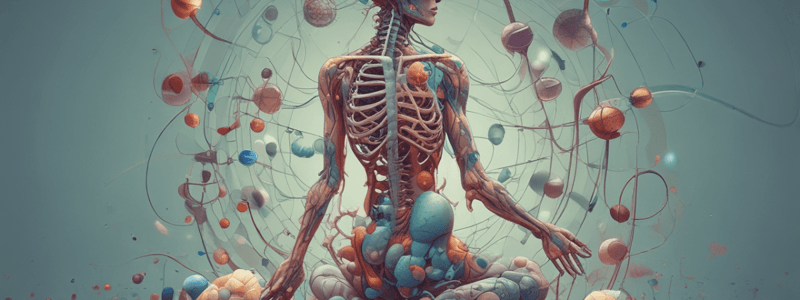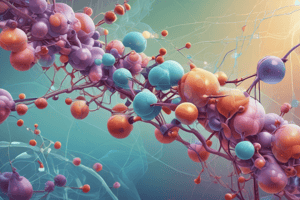Podcast
Questions and Answers
Where do allosteric modulators bind on the receptor?
Where do allosteric modulators bind on the receptor?
- On the receptor's surface
- On sites other than the agonist binding site (correct)
- On the antagonist binding site
- On the agonist binding site
What is the effect of competitive antagonism on the receptor?
What is the effect of competitive antagonism on the receptor?
- Activate the receptor
- Decrease the efficacy of the agonist
- Increase the affinity of the receptor for the agonist
- Block the effect of agonists on that receptor (correct)
What type of binding occurs in reversible competitive antagonism?
What type of binding occurs in reversible competitive antagonism?
- Reversible binding with equilibrium (correct)
- Non-equilibrium binding
- Allosteric binding
- Irreversible covalent bonding
What happens to the antagonist occupancy when the dose of agonist is increased in reversible competitive antagonism?
What happens to the antagonist occupancy when the dose of agonist is increased in reversible competitive antagonism?
What is the characteristic of irreversible competitive antagonism?
What is the characteristic of irreversible competitive antagonism?
What is the mechanism of allosteric antagonism?
What is the mechanism of allosteric antagonism?
What is the effect of an allosteric modulator on agonist activity?
What is the effect of an allosteric modulator on agonist activity?
What is an example of chemical antagonism?
What is an example of chemical antagonism?
What type of interaction occurs in competitive antagonism?
What type of interaction occurs in competitive antagonism?
What is the main reason for side effects in a drug?
What is the main reason for side effects in a drug?
What is determined by the chemical structure of a drug?
What is determined by the chemical structure of a drug?
What does a dose-response curve depict?
What does a dose-response curve depict?
What is the first point along the graph where a response above zero is reached in a dose-response curve?
What is the first point along the graph where a response above zero is reached in a dose-response curve?
What is potency a measure of in a drug?
What is potency a measure of in a drug?
What is the concentration or dose of a drug required to produce 50% of its maximal effect?
What is the concentration or dose of a drug required to produce 50% of its maximal effect?
What happens in the first phase of a dose-response curve?
What happens in the first phase of a dose-response curve?
What is the characteristic of the dose-response curve in its second phase?
What is the characteristic of the dose-response curve in its second phase?
What is the relationship between drug specificity and side effects?
What is the relationship between drug specificity and side effects?
What distinguishes a primary agonist from an allosteric agonist?
What distinguishes a primary agonist from an allosteric agonist?
Which type of agonist produces a full response?
Which type of agonist produces a full response?
What characterizes a partial agonist?
What characterizes a partial agonist?
What happens when an inhibitor binds to the orthosteric site?
What happens when an inhibitor binds to the orthosteric site?
What is the principle of biased agonism?
What is the principle of biased agonism?
How is an inverse agonist different from a standard agonist?
How is an inverse agonist different from a standard agonist?
What does constitutive activation of receptors refer to?
What does constitutive activation of receptors refer to?
What role do allosteric binding sites play in receptor function?
What role do allosteric binding sites play in receptor function?
What defines an antagonist in pharmacology?
What defines an antagonist in pharmacology?
What is the primary function of drug receptors?
What is the primary function of drug receptors?
Which type of bonding is characterized by strong and usually irreversible binding?
Which type of bonding is characterized by strong and usually irreversible binding?
In the context of pharmacodynamics, which statement best describes agonism?
In the context of pharmacodynamics, which statement best describes agonism?
What do ligand-gated ion channels primarily control?
What do ligand-gated ion channels primarily control?
Which function is NOT associated with G protein-coupled receptors (GPCRs)?
Which function is NOT associated with G protein-coupled receptors (GPCRs)?
Which of the following best describes the role of enzymes in drug action?
Which of the following best describes the role of enzymes in drug action?
Ion channels can be classified by their gating mechanisms. Which type opens in response to a ligand?
Ion channels can be classified by their gating mechanisms. Which type opens in response to a ligand?
What is a common effect of drug binding to a receptor?
What is a common effect of drug binding to a receptor?
Which of the following is NOT a type of receptor mentioned?
Which of the following is NOT a type of receptor mentioned?
What is the term for the rapid development of complete tolerance to a drug?
What is the term for the rapid development of complete tolerance to a drug?
Which of the following best describes pharmacokinetic mechanisms of drug resistance?
Which of the following best describes pharmacokinetic mechanisms of drug resistance?
What do drugs that alter the synthesis of endogenous ligands affect?
What do drugs that alter the synthesis of endogenous ligands affect?
What type of drugs primarily act by affecting the ionic milieu of biological fluids?
What type of drugs primarily act by affecting the ionic milieu of biological fluids?
What type of receptors do drugs affect that regulate the ionic milieu?
What type of receptors do drugs affect that regulate the ionic milieu?
How do drugs that activate cellular pathways function?
How do drugs that activate cellular pathways function?
Which mechanism primarily describes the action of drugs that are responsible for signal integration?
Which mechanism primarily describes the action of drugs that are responsible for signal integration?
Which category does not typically involve alteration of endogenous ligands?
Which category does not typically involve alteration of endogenous ligands?
What is a common characteristic of drugs affecting ion concentrations?
What is a common characteristic of drugs affecting ion concentrations?
Flashcards are hidden until you start studying
Study Notes
Introduction to Pharmacodynamics
- Pharmacodynamics studies the effects of drugs and their mechanisms of action.
- Individual responses to drugs can vary among patients.
Core Concepts
- Receptor Occupancy Theory: Drug response is contingent on its binding to a receptor; drugs modify existing cellular responses rather than create new ones.
- Drug Targets: Drugs interact with proteins on cell surfaces (or intracellular components) to exert effects.
Types of Drug Targets
- Physiological Receptors: Targeted by endogenous substances like hormones and neurotransmitters.
- Chemical Bonds:
- Covalent Bonds: Strong and often irreversible.
- Ionic Bonds: Weaker interactions between cations and anions.
- Other Bonds: Include hydrogen, van der Waals, and hydrophobic bonds.
Drug Actions
- Agonism: Agonists mimic endogenous substances, triggering similar responses.
- Antagonism: Antagonists inhibit or block the actions of agonists.
Drug Interaction with Enzymes and Transporters
- Enzymes: Drugs can act as substrate analogues, competitive inhibitors, or prodrugs needing activation.
- Transporters: Often employ ATP hydrolysis for active transport against concentration gradients.
Ion Channels
- Gateways regulating ion passage, can be:
- Ligand-gated: Open in response to agonists.
- Voltage-gated: Open based on membrane potential changes.
- Drugs alter ion channel function via expression modulation or direct binding.
Types of Receptors
- Type 1: Ligand-gated ion channels control fast synaptic events.
- Type 2: G Protein-coupled receptors (GPCRs) transmit signals via G proteins affecting several pathways (like cAMP and ion channels).
- Type 3 & 4: Include kinase-linked receptors and nuclear receptors.
Agonism and Antagonism
- Agonists: Can be full (complete response) or partial (suboptimal response).
- Antagonists: May competitively inhibit (reversible) or irreversibly bind to receptors.
Biased Agonism and Allosteric Modulation
- Biased Agonism: Specific agonists preferentially activate certain signaling pathways.
- Allosteric Modulators: Bind distinct from the agonist site to enhance or inhibit effects.
Dose-Response Relationships
- Dose-Response Curve: Illustrates the relationship between drug concentration and effect.
- Initial Phase: Flat response until a threshold is met.
- Slope Phase: Rapid effect increase, may experience tachyphylaxis.
Mechanisms of Drug Action
- Alter endogenous ligand levels through synthesis, storage, release, or metabolism.
- Influence ionic environments affecting blood and cellular conditions.
- Activate pathways for broader cellular signaling and integration.
Conclusion
- Understanding pharmacodynamics is crucial for predicting drug efficacy and individual patient responses.
Studying That Suits You
Use AI to generate personalized quizzes and flashcards to suit your learning preferences.




